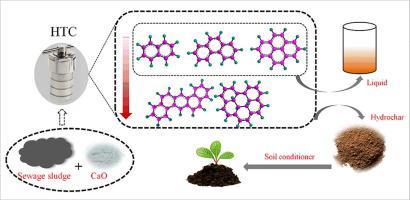Waste Management ( IF 7.1 ) Pub Date : 2020-11-17 , DOI: 10.1016/j.wasman.2020.10.025 Tingting Liu , Lifeng Tian , Zhengang Liu , Jie He , Haihui Fu , Qifei Huang , Honghai Xue , Zechun Huang

|
Hydrothermal carbonization (HTC) of sewage sludge (SS) with and without calcium oxide (CaO) introduction was conducted at 160–240 °C, and the yield and distribution of polycyclic aromatic hydrocarbons (PAHs) were evaluated for the first time. PAHs (2972.99 μg/kg) and toxic equivalent quantity (TEQ) (373.09 μg/kg) yields in SS decreased by 13.61% and 14.65%, respectively, after treatment at 160 °C and substantially increased as temperatures increased. More PAHs were distributed in the hydrochar than in the aqueous products. Hydrochar yields decreased linearly with temperature, thus increasing PAH concentration in hydrochar; 6221.98 μg/kg of PAHs in hydrocar at 240 °C exceeded agricultural use standard limits. PAH and TEQ yields at 200 °C decreased by 5.55–15.98% and 2.88–3.54%, respectively, when 3–9% CaO was added, which could be ascribed to CaO inhibition in the free radical reaction for PAH generation. Additionally, 6% CaO addition substantially weakened the acceleration effect of high temperatures on PAH formation; the decrease of PAH yield at 240 °C was 22.14%, which is higher than that at other temperatures. Consequently, the PAH concentration in hydrochar declined by 2.33–22.37%. PAH content in hydrochar obtained from CaO-assisted HTC of SS fell within agriculture use standard limit and exhibits potential for use as a soil conditioner. However, condition with a CaO amount of 15% would significantly increase TEQ yields. Considering both PAH and TEQ yields and the ecological risks of PAHs in hydrochar derived from HTC of SS, the appropriate reaction conditions were found to be 200 °C with 3–6% added CaO.
中文翻译:

CaO辅助污泥热液碳化过程中多环芳烃的分布及毒性
引入和不引入氧化钙(CaO)的污水污泥(SS)的水热碳化(HTC)在160–240°C下进行,并且首次评估了多环芳烃(PAHs)的产率和分布。在160°C处理后,SS中的PAHs(2972.99μg/ kg)和毒性当量(TEQ)(373.09μg/ kg)产量分别降低了13.61%和14.65%,并且随着温度的升高而显着增加。在水焦炭中分布的多环芳烃比在水产品中分布的多。碳氢化合物产量随温度线性降低,从而增加了碳氢化合物中PAH的浓度。在240°C下,水车中的PAHs为6221.98μg/ kg,超过了农业使用标准限值。当添加3-9%的CaO时,在200°C时PAH和TEQ的产量分别下降5.55-15.98%和2.88-3.54%,这可能归因于CaO在PAH生成自由基反应中的抑制作用。另外,添加6%CaO大大削弱了高温对PAH形成的促进作用。在240°C下,PAH收率下降了22.14%,高于其他温度下。因此,水焦中的PAH浓度下降了2.33–22.37%。从CaO辅助SS的HTC中获得的水炭中PAH含量在农业使用标准限制内,并且有潜力用作土壤改良剂。但是,CaO含量为15%的条件会显着提高TEQ产量。考虑到PAH和TEQ的收率以及SS的HTC衍生的水煤中PAHs的生态风险,发现合适的反应条件是200°C,添加3–6%的CaO。











































 京公网安备 11010802027423号
京公网安备 11010802027423号